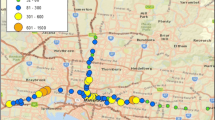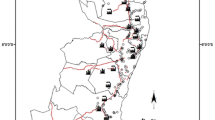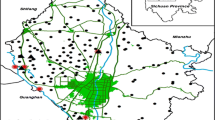Abstract
This paper reports on the cadmium results of a soil survey conducted by the State of Minnesota during the summer of 1986. The survey collected soil-dust trom the oldest census tracts of Minneapolis, St. Paul, Duluth, St. Cloud and Rochester. The results reveal fundamental differences in soil cadmium among cities. Soil cadmium exceeds 2 μg g−1 in 8.4% of the samples in Minneapolis, and 7.0, 4.0, 3.3 and 1.5% respectively of the samples collected in St. Paul, Duluth, St. Cloud and Rochester. Minneapolis and St. Paul residential houseside soil samples had cadmium levels that exceeded 2 μg g−1 in 24.5 and 21.2% respectively of the samples collected. By comparison, the Minneapolis and St. Paul residential streetside soil samples had cadmium levels that exceeded 2 μg g−1 in 1.2 and 0.6%, respectively, of the samples collected. Also the Minneapolis and St. Paul residential midyard soil samples had cadmium levels that exceeded 2 μg g−1 in 1.9 and 5.5%, respectively, of the samples collected. Cadmium levels for the combined data for all cities and communities in Minneapolis appears to be directly related to traffic flow. However, cadmium levels around housesides and in midyards do not follow patterns of traffic flow in the same manner as cadmium content of soils along streetsides. St. Paul has an anomalously high cadmium content toward the east of the city compared with the west side of the city. The Pigs Eye sewage sludge incinerator located east of the city is the most likely source of cadmium to cause this pattern. This study provides essential urban background information about both the fundamental environmental patterns of cadmium as well as processes which appear to operate to cause those patterns.
Similar content being viewed by others
References
ATSDR. 1988.Toxicological Profile for Cadmium. Agency for Toxic Substances and Disease Registry, US Public Health Service and US Environmental Protection Agency, Atlanta, GA.
Bergomi, M., Borella, P., Fanlazzi, G., Tartoni, P.L. and Vivoli, G. 1987, Cadmium levels in tooth, hair and blood of children.Int. Conf, on Heavy Metals in the Environment. Vol.2, pp.92–94.
Chi, C.T., Hughes, T.S., Ctvrtnicek, T.E., Horn, D.A. and Serth, A.W. 1978.Source Assessment: Rubber Processing, Stale of the Art. Environmental Protection Technology Series. US EPA Industrial Environmental Research Laboratory, Cincinnati, OH 45268, USA.
Coleman, R., Leaf, J., Coffey, E. and Siebert, P. 1979.Assessment of Human Exposures to Atmospheric Cadmium. Office of Air Quality, Planning and Standards, US EPA Research Triangle Park, NC EM-450/5-79-007.
Dowdy, R.H., Bray, B.J., Goodrich, R.D., Marten, G.C., Pamp, D.E. and Larson, W.E. 1983. Performance of goats and lambs fed corn silage produced on sludge-amended soil.J. Environ. Qual.,12, 460–472.
Fergusson, J.E., Hayes, R.W., Yong, T.S. and Thiew, S.H. 1980. Heavy metal pollution by traffic in Christchurch, New Zealand: Lead and cadmium content of dust, soil, and plant samples.New Zealand J. of Sci.,23, 293–320.
Hutton, M., Wadge, A. and Milligan, P.J., 1988. Environmental levels of cadmium and lead in the vicinity of a major refuse incinerator.Atmospheric Environ.,22(2), 411–416.
Martin, J. and Lanegran, D. 1983.Where we Live: The Residential Districts of Minneapolis and St. Paul Minneapolis. University of Minnesota Press.
Mielke, H.W., Adams, J.L., Reagan, P.L. and Mielke, P.W. Jr. 1989. Soil-dust lead and childhood lead exposure as a function of city-size and community traffic flow: The case for lead abatement in Minnesota.Environ. Geochem., Health., 9 (Supplement entitled, Lead in Soil: Issues and Guidelines, B.E. Davies and B.C. Wixson, eds), 243–271.
Mielke, H.W., Anderson, J., Berry, K., Mielke, P.W. Jr., Chaney, R. and Leech, M. 1983. Lead concentrations in inner-city soils as a factor in the child lead problem.Am. J. Pub. Health,73(12), 1366–1369.
Mielke, H.W., Blake, B., Burroughs, S. and Hassinger, N. 1984. Urban lead levels in Minneapolis: The case of the Hmong children.Environ. Res.,34, 64–76.
Solomon, R.L. and Hartford, J.W. 1976. Lead and cadmium in dusts and soils in a small urban community.Environ. Sci. Technol.,10(8), 773–777.
Tennant, C.J. 1985. Cadmium in the environment and high risk population groups.Int. Conf. on Heavy Metals in the Environ., Vol.2, pp.143–146.
Tiemey, D.R., Blackwood, T.R. and Wilson, R.D. 1979. Status assessment of toxic chemicals: Cadmium. Industrial Environmental Research Laboratory Office of Research and Development. US EPA, Cincinnati, Ohio. EPA-600/2-79-210f.
US Department of Transportation. 1977. National Functional System Mileage and Travel Summary from the 1976 National Highway inventory and performance study. Federal Highway Administration, Office of Highway Planning, Washington, DC.
US EPA 1979. Evaluation of paniculate emission factors for vehicle tire wear. Office of Air Quality Planning and Standards. US EPA Research Triangle Park, NC. EPA-450/4-79-014.
Wadge, A. and Hutton, M. 1987. The cadmium and lead content of suspended paniculate matter emitted from a UK refuse incinerator.Sci. Total Environ.,67, 91–95.
Author information
Authors and Affiliations
Rights and permissions
About this article
Cite this article
Mielke, H.W., Adams, J.L., Chaney, R.L. et al. The pattern of cadmium in the environment of five Minnesota cities. Environ Geochem Health 13, 29–34 (1991). https://doi.org/10.1007/BF01783493
Received:
Accepted:
Issue Date:
DOI: https://doi.org/10.1007/BF01783493




